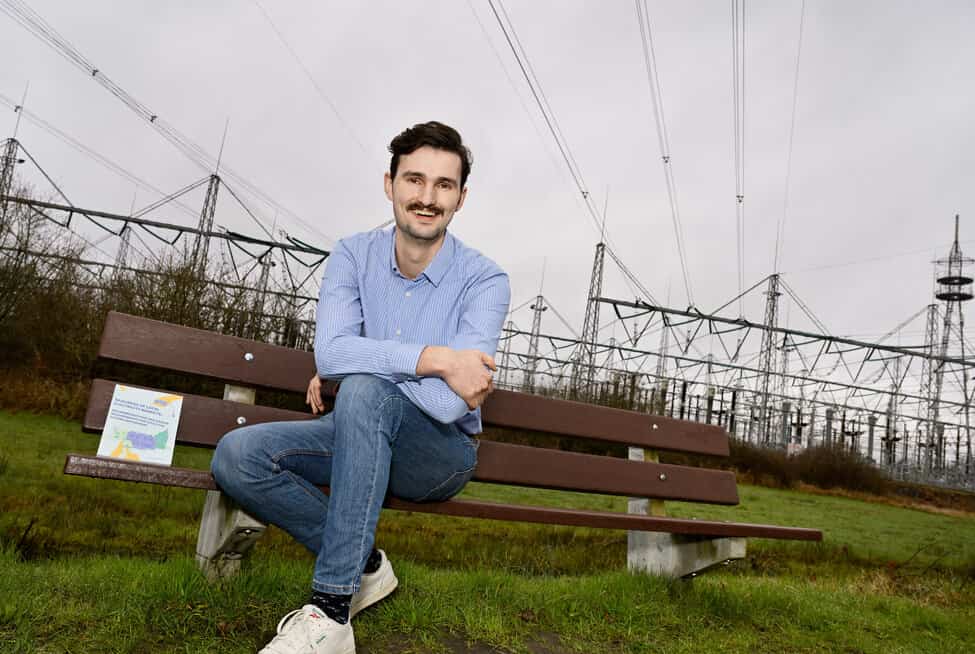
Nearly all of the Dutch electricity network is overloaded these days. Consequently, new companies need to wait a long time to connect to the grid, and the integration of more green power into the grid is slowed down. As society embraces electrification and energy production decentralizes, the pressure on the electricity grid increases. The higher electricity demand is the main reason for grid congestion, which happens when electricity doesn’t reach the final consumer due to a grid overload. At the heart of grid congestion are limitations in the grid’s capacity to transmit energy to meet the power demand.
What are possible solutions to grid congestion? If you ask Sjoerd Doumen, switching to local electricity markets (LEMs) is one of the options to consider. LEMs set a framework for local electricity trading, enhancing flexibility in energy use. Doumen’s Ph.D. work at the Eindhoven University of Technology (TU/e) investigated the adoption of LEMs, finding out that they can relieve stress from the grid, ease the uptake of renewable energy, and make energy cheaper for everyone.
Road to 2050
It might seem far off, but 2050 is 26 years away. 2050 is the year set by EU countries to become climate-neutral, aligning with the targets previously set by the Paris Agreement. What does climate neutral mean? For a service, process, or product to be climate neutral means that all greenhouse gases it produces are offset by climate measures. Although reducing emissions is the primary way to achieve climate neutrality, this does not mean there are no emissions; they are offset through support for climate protection projects.
What steps do we need to take to achieve climate neutrality? How do we make our economy climate-neutral? In Road to 2050, we will look at the challenges we need to overcome.
Trading at a local level
Currently, electricity is traded nationally; energy suppliers like Essent, Engie, or Vattenfall procure energy and sell it to their customers. By contrast, LEMs are market platforms for trading locally produced renewable energy among customers within a close community. Doumen’s work, which studied the implementation of an LEM in a street, aimed at understanding the level of readiness for a switch from a centralized to a more decentralized energy trade.
An example of an LEM is a pilot conducted in the Swiss village of Walenstadt a few years ago, which created a blockchain-based market for trading electricity. 37 households could access the energy company Water and Electricity Works Walenstadt portal to trade electricity locally. Citizens could buy from the company and sell their excess solar power. Consumers could adjust their price limits, but the price cap for local solar power was nearly never higher than the one for grid power.
“I think some basis to start switching to LEMs is there. For instance, as long as you and I have the same energy supplier, we can trade energy provided we adhere to the current market day. However, many barriers still exist. Energy providers are not incentivized to provide customers with these services, and consumers can’t trade electricity as free as LEMs would require them. More legislation is needed,” underlines Doumen.

Flexibility and complexity
The TU/e graduate, who now works as a consultant for ENTRNCE, an energy trading platform, sees several pros in LEMs. “Among the pros are a greater control of energy, the addition of a local energy price component, and the chance to have an extra tool to handle congestion, besides a sense of cooperation between those who participate in it,” he outlines.
Renewable sources’ production peaks call for higher grid flexibility. Such resilience is something LEMs can offer with the addition of a local energy price addition, such as a dynamic rate depending on the local grid conditions. Trading at a local level can also help spread peak consumption throughout the day.
Nevertheless, LEMs come with a higher complexity, in terms of technology and user understanding. “If one doesn’t pay attention, one might end up paying more than the average price of electricity. Ultimately, we will need automated systems to check the prices and trade electricity otherwise, no one will do so,” Doumen suggests, stressing the need for more technology to step in and assist LEM mechanisms.

Markets are evolving
In addition to more rules to facilitate energy trading, Doumen sees incentives as necessary to foster LEM adoption. Although he believes that compensating those who produce green electricity and feed into the grid, measures like the net metering scheme for solar panels are not the right way to subsidize. Rather, the consultant would opt for tax discounts for those who trade their electricity. As an example, Brussels citizens can share renewable energy and get a discount on the electricity they consume depending on the amount of local energy they use.
Besides the technical and legislative hurdles to be overcome, Doumen also pays attention to the social implications of adopting LEMs. Overall, assisting people navigate the increasing flexibility and volatility of electricity markets is paramount. “It has been scientifically proven that having a dynamic electricity contract is better than a fixed tariff one. People still hesitate to switch to them as they prefer stability over market fluctuations,” Doumen underlines.
Yet, flexibility in the electricity components markets—transportation, electricity, and consumption—is the only way to manage green power intake and use capacity more smartly to curtail congestion problems. However, LEMs are just one of the solutions that can tackle grid congestion. In the upcoming episode of Road to 2050, we will delve into another IT solution to better handle electricity distribution.


